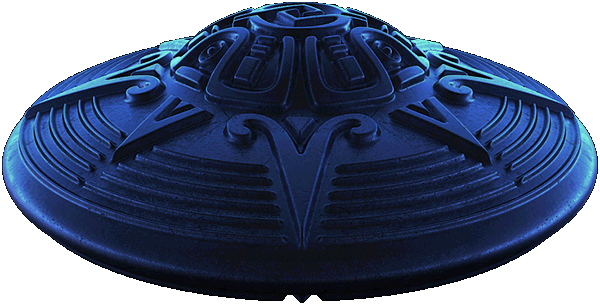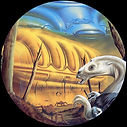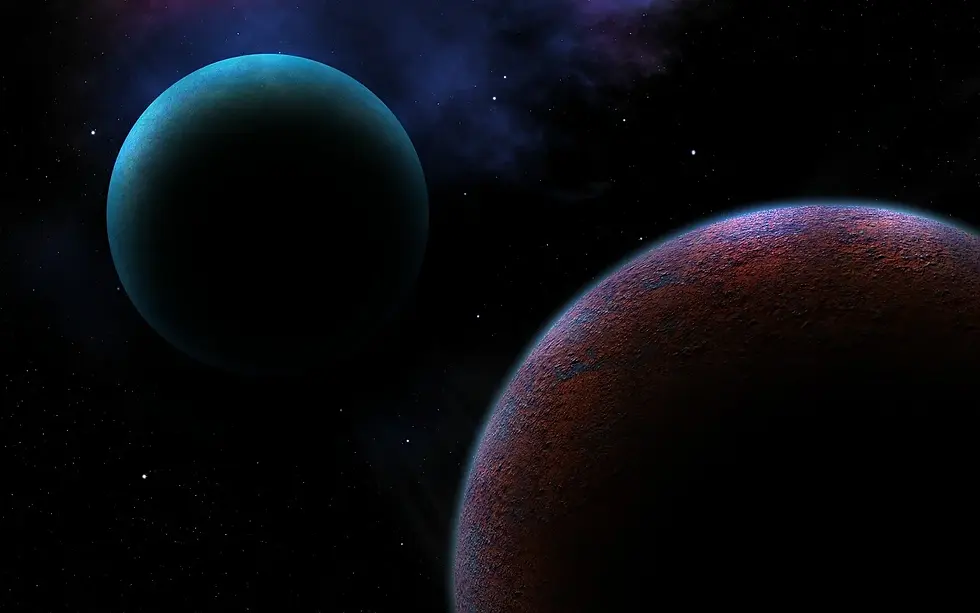














MARS
Mars is the fourth planet from the Sun, and the seventh largest. It’s the only planet we know of inhabited entirely by robots.
Mars Overview
Mars is no place for the faint-hearted. It’s dry, rocky, and bitter cold. The fourth planet from the Sun, Mars, is one of Earth's two closest planetary neighbors (Venus is the other). Mars is one of the easiest planets to spot in the night sky — it looks like a bright red point of light.
Despite being inhospitable to humans, robotic explorers — like NASA's Perseverance rover and Mars Reconnaissance Orbiter — serve as pathfinders to eventually get astronauts to the surface of the Red Planet.
Introduction
Mars is one of the most explored bodies in our solar system, and it's the only planet where we've sent rovers to roam the alien landscape. NASA missions have found lots of evidence that Mars was much wetter and warmer, with a thicker atmosphere, billions of years ago.
Mars was named by the Romans for their god of war because its reddish color was reminiscent of blood. The Egyptians called it "Her Desher," meaning "the red one."
Even today, it is frequently called the "Red Planet" because iron minerals in the Martian dirt oxidize, or rust, causing the surface to look red.
Unable to render the provided source
A 3D model of Mars.
NASA Visualization Technology Applications and Development (VTAD)
Namesake
Mars was named by the ancient Romans for their god of war because its reddish color was reminiscent of blood. Other civilizations also named the planet for this attribute – for example, the Egyptians called it "Her Desher," meaning "the red one." Even today, it is frequently called the "Red Planet" because iron minerals in the Martian dirt oxidize, or rust, causing the surface to look red.
Potential for Life
Scientists don't expect to find living things currently thriving on Mars. Instead, they're looking for signs of life that existed long ago, when Mars was warmer and covered with water.
Size and Distance
With a radius of 2,106 miles (3,390 kilometers), Mars is about half the size of Earth. If Earth were the size of a nickel, Mars would be about as big as a raspberry.
From an average distance of 142 million miles (228 million kilometers), Mars is 1.5 astronomical units away from the Sun. One astronomical unit (abbreviated as AU), is the distance from the Sun to Earth. From this distance, it takes sunlight 13 minutes to travel from the Sun to Mars.
Orbit and Rotation
As Mars orbits the Sun, it completes one rotation every 24.6 hours, which is very similar to one day on Earth (23.9 hours). Martian days are called sols – short for "solar day." A year on Mars lasts 669.6 sols, which is the same as 687 Earth days.
Mars' axis of rotation is tilted 25 degrees with respect to the plane of its orbit around the Sun. This is another similarity with Earth, which has an axial tilt of 23.4 degrees. Like Earth, Mars has distinct seasons, but they last longer than seasons here on Earth since Mars takes longer to orbit the Sun (because it's farther away). And while here on Earth the seasons are evenly spread over the year, lasting 3 months (or one quarter of a year), on Mars the seasons vary in length because of Mars' elliptical, egg-shaped orbit around the Sun.
Spring in the northern hemisphere (autumn in the southern) is the longest season at 194 sols. Autumn in the northern hemisphere (spring in the southern) is the shortest at 142 days. Northern winter/southern summer is 154 sols, and northern summer/southern winter is 178 sols.
Moons
Mars has two small moons, Phobos and Deimos, that may be captured asteroids. They're potato-shaped because they have too little mass for gravity to make them spherical.
The moons get their names from the horses that pulled the chariot of the Greek god of war, Ares.
Phobos, the larger of Mars' two moons, is seen in this image taken by NASA's High Resolution Imaging Science Experiment (HiRISE) camera on the Mars Reconnaissance Orbiter .
NASA/JPL-Caltech/University of Arizona
Phobos, the innermost and larger moon, is heavily cratered, with deep grooves on its surface. It is slowly moving towards Mars and will crash into the planet or break apart in about 50 million years.
Deimos is about half as big as Phobos and orbits two and a half times farther away from Mars. Oddly-shaped Deimos is covered in loose dirt that often fills the craters on its surface, making it appear smoother than pockmarked Phobos.
This enhanced-color image of Deimos, the smaller of the two moons of Mars, was taken on Feb. 21, 2009. The image was taken by HiRISE (High Resolution Imaging Science Experiment) on NASA's Mars Reconnaissance Orbiter.
NASA/JPL-Caltech/University of Arizona
Go farther. Explore the Moons of Mars ›
Rings
Mars has no rings. However, in 50 million years when Phobos crashes into Mars or breaks apart, it could create a dusty ring around the Red Planet.
Formation
When the solar system settled into its current layout about 4.5 billion years ago, Mars formed when gravity pulled swirling gas and dust in to become the fourth planet from the Sun. Mars is about half the size of Earth, and like its fellow terrestrial planets, it has a central core, a rocky mantle, and a solid crust.
Structure
Mars has a dense core at its center between 930 and 1,300 miles (1,500 to 2,100 kilometers) in radius. It's made of iron, nickel, and sulfur. Surrounding the core is a rocky mantle between 770 and 1,170 miles (1,240 to 1,880 kilometers) thick, and above that, a crust made of iron, magnesium, aluminum, calcium, and potassium. This crust is between 6 and 30 miles (10 to 50 kilometers) deep.
Surface
The Red Planet is actually many colors. At the surface, we see colors such as brown, gold, and tan. The reason Mars looks reddish is due to oxidization – or rusting – of iron in the rocks, regolith (Martian “soil”), and dust of Mars. This dust gets kicked up into the atmosphere and from a distance makes the planet appear mostly red.
Interestingly, while Mars is about half the diameter of Earth, its surface has nearly the same area as Earth’s dry land. Its volcanoes, impact craters, crustal movement, and atmospheric conditions such as dust storms have altered the landscape of Mars over many years, creating some of the solar system's most interesting topographical features.
A large canyon system called Valles Marineris is long enough to stretch from California to New York – more than 3,000 miles (4,800 kilometers). This Martian canyon is 200 miles (320 kilometers) at its widest and 4.3 miles (7 kilometers) at its deepest. That's about 10 times the size of Earth's Grand Canyon.
Mars is home to the largest volcano in the solar system, Olympus Mons. It's three times taller than Earth's Mt. Everest with a base the size of the state of New Mexico.
Mars appears to have had a watery past, with ancient river valley networks, deltas, and lakebeds, as well as rocks and minerals on the surface that could only have formed in liquid water. Some features suggest that Mars experienced huge floods about 3.5 billion years ago.
There is water on Mars today, but the Martian atmosphere is too thin for liquid water to exist for long on the surface. Today, water on Mars is found in the form of water-ice just under the surface in the polar regions as well as in briny (salty) water, which seasonally flows down some hillsides and crater walls.
Atmosphere
Mars has a thin atmosphere made up mostly of carbon dioxide, nitrogen, and argon gases. To our eyes, the sky would be hazy and red because of suspended dust instead of the familiar blue tint we see on Earth. Mars' sparse atmosphere doesn't offer much protection from impacts by such objects as meteorites, asteroids, and comets.
The temperature on Mars can be as high as 70 degrees Fahrenheit (20 degrees Celsius) or as low as about -225 degrees Fahrenheit (-153 degrees Celsius). And because the atmosphere is so thin, heat from the Sun easily escapes this planet. If you were to stand on the surface of Mars on the equator at noon, it would feel like spring at your feet (75 degrees Fahrenheit or 24 degrees Celsius) and winter at your head (32 degrees Fahrenheit or 0 degrees Celsius).
Occasionally, winds on Mars are strong enough to create dust storms that cover much of the planet. After such storms, it can be months before all of the dust settles.
Magnetosphere
Mars has no global magnetic field today, but areas of the Martian crust in the southern hemisphere are highly magnetized, indicating traces of a magnetic field from 4 billion years ago.


On its way up the side of Jezero Crater, the agency’s latest Red Planet off-roader peers all the way back to its landing site and scopes the path ahead.
NASA’s Perseverance Mars rover is negotiating a steeply sloping route up Jezero Crater’s western wall with the aim of cresting the rim in early December. During the climb, the rover snapped not only a sweeping view of Jezero Crater’s interior, but also imagery of the tracks it left after some wheel slippage along the way.
An annotated version of the mosaic captured by Perseverance highlights nearly 50 labeled points of interest across Jezero Crater, including the rover’s landing site. The 44 images that make up the mosaic were taken Sept. 27.
NASA/JPL-Caltech/ASU/MSSS
Stitched together from 44 frames acquired on Sept. 27, the 1,282nd Martian day of Perseverance’s mission, the image mosaic features many landmarks and Martian firsts that have made the rover’s 3½-year exploration of Jezero so memorable, including the rover’s landing site, the spot where it first found sedimentary rocks, the location of the first sample depot on another planet, and the final airfield for NASA’s Ingenuity Mars Helicopter. The rover captured the view near a location the team calls “Faraway Rock,” at about the halfway point in its climb up the crater wall.
“The image not only shows our past and present, but also shows the biggest challenge to getting where we want to be in the future,” said Perseverance’s deputy project manager, Rick Welch of NASA’s Jet Propulsion Laboratory in Southern California. “If you look at the right side of the mosaic, you begin to get an idea what we’re dealing with. Mars didn’t want to make it easy for anyone to get to the top of this ridge.”
Visible on the right side of the mosaic is a slope of about 20 degrees. While Perseverance has climbed 20-degree inclines before (both NASA’s Curiosity and Opportunity rovers had crested hills at least 10 degrees steeper), this is the first time it’s traveled that steep a grade on such a slippery surface.
This animated orbital-map view shows the route NASA’s Perseverance Mars rover has taken since its February 2021 landing at Jezero Crater to July 2024, when it took its “Cheyava Falls” sample. As of October 2024, the rover has driven over 30 kilometers (18.65 miles), and has collected 24 samples of rock and regolith as well as one air sample. NASA/JPL-Caltech
Soft, Fluffy
During much of the climb, the rover has been driving over loosely packed dust and sand with a thin, brittle crust. On several days, Perseverance covered only about 50% of the distance it would have on a less slippery surface, and on one occasion, it covered just 20% of the planned route.
“Mars rovers have driven over steeper terrain, and they’ve driven over more slippery terrain, but this is the first time one had to handle both — and on this scale,” said JPL’s Camden Miller, who was a rover planner, or “driver,” for Curiosity and now serves the same role on the Perseverance mission. “For every two steps forward Perseverance takes, we were taking at least one step back. The rover planners saw this was trending toward a long, hard slog, so we got together to think up some options.”
On Oct. 3, they sent commands for Perseverance to test strategies to reduce slippage. First, they had it drive backward up the slope (testing on Earth has shown that under certain conditions the rover’s “rocker-bogie” suspension system maintains better traction during backward driving). Then they tried cross-slope driving (switchbacking) and driving closer to the northern edge of “Summerland Trail,” the name the mission has given to the rover’s route up the crater rim.
NASA’s Perseverance drives first backward then forward as it negotiates some slippery terrain found along a route up to the rim of Jezero Crater on Oct. 15. The Mars rover used one of its navigation cameras to capture the 31 images that make up this short video.
NASA/JPL-Caltech
Data from those efforts showed that while all three approaches enhanced traction, sticking close to the slope’s northern edge proved the most beneficial. The rover planners believe the presence of larger rocks closer to the surface made the difference.
“That’s the plan right now, but we may have to change things up the road,” said Miller. “No Mars rover mission has tried to climb up a mountain this big this fast. The science team wants to get to the top of the crater rim as soon as possible because of the scientific opportunities up there. It’s up to us rover planners to figure out a way to get them there.”
Tube Status
In a few weeks, Perseverance is expected to crest the crater rim at a location the science team calls “Lookout Hill.” From there, it will drive about another quarter-mile (450 meters) to “Witch Hazel Hill.” Orbital data shows that Witch Hazel Hill contains light-toned, layered bedrock. The team is looking forward to comparing this new site to “Bright Angel,” the area where Perseverance recently discovered and sampled the “Cheyava Falls” rock.
Tracks shown in this image indicate the slipperiness of the terrain Perseverance has encountered during its climb up the rim of Jezero Crater. The image was taken by one of rover’s navigation cameras on Oct. 11.
NASA/JPL-Caltech
The rover landed on Mars carrying 43 tubes for collecting samples from the Martian surface. So far, Perseverance has sealed and cached 24 samples of rock and regolith (broken rock and dust), plus one atmospheric sample and three witness tubes. Early in the mission’s development, NASA set the requirement for the rover to be capable of caching at least 31 samples of rock, regolith, and witness tubes over the course of Perseverance’s mission at Jezero. The project added 12 tubes, bringing the total to 43. The extras were included in anticipation of the challenging conditions found at Mars that could result in some tubes not functioning as designed.
NASA decided to retire two of the spare empty tubes because accessing them would pose a risk to the rover’s small internal robotic sample-handling arm needed for the task: A wire harness connected to the arm could catch on a fastener on the rover’s frame when reaching for the two empty sample tubes.
With those spares now retired, Perseverance currently has 11 empty tubes for sampling rock and two empty witness tubes.
More About Perseverance
A key objective of Perseverance’s mission on Mars is astrobiology, including caching samples that may contain signs of ancient microbial life. The rover will characterize the planet’s geology and past climate, to help pave the way for human exploration of the Red Planet and as the first mission to collect and cache Martian rock and regolith.
NASA’s Mars Sample Return Program, in cooperation with ESA (European Space Agency), is designed to send spacecraft to Mars to collect these sealed samples from the surface and return them to Earth for in-depth analysis.
The Mars 2020 Perseverance mission is part of NASA’s Moon to Mars exploration approach, which includes Artemis missions to the Moon that will help prepare for human exploration of the Red Planet.
NASA’s Jet Propulsion Laboratory, which is managed for the agency by Caltech, built and manages operations of the Perseverance rover.
For more about Perseverance:


Mars is the only planet we know of inhabited entirely by robots.
Artist's concept depicts astronauts and human habitats on Mars.
NASA/JPL-Caltech/MSSS
-
From Robots to Humans
Recorded observations of Mars date back more than 4,000 years. Led by our curiosity of the cosmos, NASA has sent a carefully selected international fleet of robotic orbiters, landers and rovers to keep a continuous flow of scientific information and discovery from Mars. The science and technology developed through Mars Exploration missions will enable humans to one day explore the Red Planet in person.
Rover Basics
Each robotic explorer sent to the Red Planet has its own unique capabilities driven by science. Many attributes of a rover take on human-like features, such as “heads,” “bodies,” and “arms and legs.”
NASA's Mars Perseverance rover acquired this image using its SHERLOC WATSON camera, located on the turret at the end of the rover's robotic arm.
NASA/JPL-Caltech
Anatomy of a Rover
Body
A strong structure that protects the rovers' "vital organs" like computers, electronics and electronics, some of which keep the vital organs protected and temperature-controlled.
Brains
Computers to process information.
Temperature controls
Internal heaters, a layer of insulation, and more to protect the rover from extreme temperatures.
"Neck and Head"
A mast for the cameras to give the rovers a human-scale view.
Eyes and other "senses"
Cameras and instruments that give the rovers information about their environment to aid in navigation and science investigations.
Arm
Much like a human arm, the robotic arm has flexibility through three joints: the rover's shoulder, elbow, and wrist to maneuver the instruments that help scientists get up-close and personal with Martian rocks and soil.
Wheels and "Legs"
Parts for mobility.
Energy
Batteries and solar panels.
Communications
Antennas for "speaking" and "listening."
Hidden Messages
From bracelets to body art, humans have adorned themselves for thousands of years. The spacecraft that we send to Mars are no different! Many NASA orbiters, landers, and rovers fly with artwork, signs, and symbols on board that reflect the time and place they were made.


Mission Concept
Mars Sample Return, a joint campaign being planned by NASA and the European Space Agency (ESA), would be a multiple missions and components, with the goal of bringing Mars rock, loose surface material, and gas samples to Earth for detailed laboratory analysis.
Quick Facts
1. Interactions with Multiple Vehicles: The first time several vehicles (a lander, a rocket, and multiple helicopters) would land on the surface of Mars at the same time.
2. First Rocket Launch From Another Planet: First launch from the surface of another planet with the Mars Ascent Vehicle.
3. Seeking Ancient Answers: The delivery of the first set of carefully selected samples to Earth from a place known to be friendly to life in the distant past.
4. First Round-trip Mission to Another Planet: ESA's Earth Return Orbiter would be the first spacecraft to: make a roundtrip journey from Earth to Mars and back, bring back samples from Mars to Earth, and propel itself out of Mars orbit.
5. Earth Entry System Provides Free Fall Landing: The Earth Entry System would be the first sample return vehicle designed to complete a free fall landing (at approximately 90 mph [about 145 kph]). Mission engineers designed the spacecraft to land safely without a parachute.
A Team Effort
Mars Sample Return is a joint campaign being planned by NASA and the ESA (European Space Agency)
. Mars Sample Return would entail multiple missions and components, with the goal of bringing Mars rock, loose surface material, and gas samples to Earth for detailed laboratory analysis.
The Mars Perseverance rover is the first leg of this international, interplanetary relay team. Its job is to collect and cache samples on Mars. A Sample Retrieval Lander would land near or in Jezero Crater, bringing a small rocket on which the samples collected by Perseverance would be loaded. Once the sample cache is launched off the Red Planet, another spacecraft would capture it in Mars orbit, and then bring it to Earth safely.
These first collected and returned samples could answer a key question: Did life ever exist on Mars? Only by bringing the samples to Earth can we truly answer the question by using the most sophisticated, state-of-the-art labs, at a time when future generations can study them using techniques yet to be invented.
NASA/ESA
The Interplanetary Relay Team
Mars Perseverance Rover
The Mars Perseverance rover is the first leg of this international, interplanetary relay team. Its job is to collect and cache samples on Mars.
The Mars Perseverance rover is the first leg of this international, interplanetary relay team. Its job is to collect and cache samples on Mars.
NASA/JPL-Caltech
NASA's Sample Retrieval Lander would be the first ever to bring along a rocket — NASA's Mars Ascent Vehicle, to help achieve the goal of bringing the samples safely to Earth for study.
NASA/JPL-Caltech
Sample Retrieval Lander
NASA's Sample Retrieval Lander (SRL) would be the first ever to bring along a rocket — NASA's Mars Ascent Vehicle, to help achieve the goal of bringing the samples safely to Earth for study.
-
Mars Ascent Vehicle
The Mars Ascent Vehicle (MAV) would be the first rocket ever to launch off the surface of another planet, and would transport the sample tubes containing Martian rock, atmosphere, and loose surface material into orbit around Mars.
-
Sample Recovery Helicopters
The Sample Recovery Helicopters (SRH) are modeled after the successful Ingenuity Mars Helicopter, carried to the Red Planet by NASA's Perseverance rover. These specialized rotorcraft would be a secondary method of sample retrieval for the campaign.
-
Earth Return Orbiter
The Earth Return Orbiter (ERO), provided by ESA, would be the first interplanetary spacecraft to capture an object in orbit around another planet and make a full round trip to Mars and back.
The Mars Ascent Vehicle would be the first rocket ever to launch off the surface of another planet, and would transport the sample tubes containing Martian rock, atmosphere, and loose surface material into orbit around Mars.
The Sample Recovery Helicopters are modeled after the successful Ingenuity Mars Helicopter, carried to the Red Planet by NASA's Perseverance rover. These specialized rotorcraft would be a secondary method of sample retrieval for the campaign.
The Earth Return Orbiter (ERO), provided by ESA, would be the first interplanetary spacecraft to capture an object in orbit around another planet and make a full round trip to Mars and back.

Mars Ascent Vehicle
The Mars Ascent Vehicle will carry tubes containing Martian rock and soil samples into orbit around Mars, where ESA's Earth Return Orbiter spacecraft will enclose them in a highly secure containment capsule and deliver them to Earth.
Anatomy of the Mars Ascent Vehicle
This illustration shows NASA's Mars Ascent Vehicle (MAV) in powered flight. The MAV will carry tubes containing Martian rock and soil samples into orbit around Mars, where ESA's Earth Return Orbiter spacecraft will enclose them in a highly secure containment capsule and deliver them to Earth.
NASA/JPL-Caltech
The Mars Ascent Vehicle is a lightweight rocket that would transport the Orbiting Sample, into Mars orbit as part of NASA and European Space Agency's (ESA) Mars Sample Return Program. It would be the first rocket ever to launch off the surface of another planet, and would transport the sample tubes containing Martian rock, atmosphere, and loose surface material into orbit around Mars. The rocket and enclosed sample container would travel to Mars inside the Sample Retrieval Lander, and would remain aboard until loaded with samples and prepped for launch. Once the sample container reaches Mars orbit orbit, ESA's Earth Return Orbiter would capture and store it in a secure containment capsule for safe delivery to Earth.
Anatomy of the Mars Ascent Vehicle
Key parts on the Mars Ascent Vehicle.
NASA/JPL-Caltech
Tech Specs
Height
10 feet (3 meters) tall
Mass
Approximately 992 pounds (450 kilograms)
Weight
Approximately 992 pounds (approximately 450 kilograms) on Earth
Approximately 372 pounds (approximately 69 kilograms) on Mars
Diameter
1.6 feet (0.5 meters) wide
Speed
2.5 miles per second (about 4 kilometers per second), the MAV would reach its desired orbit about 10 minutes after launch
Fuel
Two-stage, solid propellant rocket
Orbiting Sample Container
Mars Sample Return Orbiting Sample Container Concept Illustration.
NASA/JPL-Caltech
The Orbiting Sample container would hold up to 30 tubes filled with Martian rock and atmospheric samples from the Perseverance rover. NASA's Mars Perseverance rover has been collecting Martian rock and atmospheric samples since landing on Mars in February 2021. The rover has been caching the samples for potential pickup by the Mars Sample Return Campaign. Held safely inside of the rover, the samples would be transferred to the Orbiting Sample aboard the Mars Ascent Vehicle as the next step on its journey to Earth.
Tech Specs
Size
Approximately 9.5 inches high by approximately 8.9 inches wide (approximately 0.24 meters high by approximately 0.23 meters wide)
Weight/Mass
Approximately 24 pounds (approximately 11 kilograms)
Number of Tubes
Would carry up to 30 sample tubes
